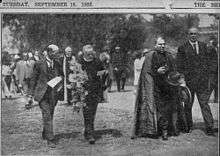Bonaventura Cerretti
| Styles of Bonaventura Cerretti | |
|---|---|
 | |
| Reference style | His Eminence |
| Spoken style | Your Eminence |
| Informal style | Cardinal |
| See | Velletri (suburbicarian see) |

Bonaventura Cerretti (17 June 1872 – 8 May 1933) was an Italian cardinal of the Roman Catholic Church. He served as Prefect of the Supreme Tribunal of the Apostolic Signatura from 1931 until his death, and was elevated to the cardinalate in 1925.
Biography
Bonaventura Cerretti was born in Orvieto and educated at the seminary in Spoleto and, later, at the Pontifical Gregorian University in Rome as well as the Royal University, Rome.
From 1895, year of his ordination, until 1899 he did pastoral work in the Diocese of Orvieto. He was then invited to become a staff member in the Vatican Secretariat of State where he worked from 1899 until 1904. He was created Privy chamberlain of His Holiness on 13 January 1904. He then served as secretary to apostolic delegate in Mexico from 1904 to 1906 then as auditor in the apostolic delegation to the United States from 1906 to 1914.
He was appointed as Titular Archbishop of Philippopolis in Thracia on 15 April 1914 by Pope Pius X. He was transferred to the titular see of Corinth on 10 May 1914. He was consecrated as a bishop on 19 July 1914 by Cardinal Rafael Merry del Val, Cardinal Secretary of State. He was appointed as the first apostolic delegate in Australia and New Zealand in 1914. He represented the Holy See and thus tried to get the Great Powers to accept the Peace Note of Pope Benedict XV at the Paris Peace Conference in Paris from May to June 1919. He was appointed to serve as nuncio in France in 1921.
In 1925 He was created Cardinal-Priest of Santa Cecilia in Trastevere by Pope Pius XI in the consistory of 14 December 1925. In 1928 he revisited Australia as papal legate to the 29th International Eucharistic Congress in Sydney; as part of this visit, he laid the foundation stone for the Holy Name Cathedral, Brisbane (which was ultimately never completed).[1]
In 1926 he negotiated with Aristide Briand an agreement giving the French interior and foreign ministers a role in the appointment of French diocesan bishops (i.e. outside Alsace-Moselle where special arrangements apply).
He was appointed as archpriest of the Basilica of Saint Mary Major on 16 July 1930. Pope Pius appointed him as Prefect of the Apostolic Signatura on 12 October 1931. He opted for the order of cardinal bishops, taking the suburbicarian see of Velletri in 1933. Camerlengo of the Sacred College of Cardinals, 1933; he died shortly after.
In 1930 in Rome he was painted by his friend the Swiss-born American artist Adolfo Müller-Ury (1862-1947). The picture is believed to hang in the Palazzo Municipale di Orvieto. [2]
Cerretti died in Rome and was buried in the basilica of Santa Maria in Trastevere. The chapel at St Patrick's Seminary, Manly in Sydney, Australia is named after him.
References
- ↑ "Holy Name Cathedral.". The Longreach Leader (Qld. : 1923 - 1954). Qld.: National Library of Australia. 21 September 1928. p. 26. Retrieved 24 December 2013.
- ↑ E. Cerretti, Il Cardinale Bonaventura Cerretti, Rome, 1939, p. 157, and Plate XIII, (opposite p. 368).
| Preceded by Vincenzo Vannutelli |
Archpriest of the Basilica di Santa Maria Maggiore 16 July 1930–8 May 1933 |
Succeeded by Angelo Dolci |
| Preceded by Francesco Ragonesi |
Prefect of the Supreme Tribunal of the Apostolic Signatura 12 October 1931–8 May 1933 |
Succeeded by Enrico Gasparri |
| Preceded by Basilio Pompilj |
Cardinal-Bishop of Velletri 13 March 1933–8 May 1933 |
Succeeded by Enrico Gasparri |
| Preceded by Luigi Sincero |
Camerlengo of the Sacred College of Cardinals 1933 |
Succeeded by Achille Locatelli |